(Photos © J. Maus/BikePortland)
I’m trying to justify an article I just read in The Oregonian with what I saw on a ride through Portland Sunday. And I can’t do it.

The article sounds an alarm that the ubiquitous “6 feet” social distancing recommendation might not be nearly enough — especially when outdoors. It also has specific information about how the virus can spread among people bicycling. “Richard Corsi, a Portland State University dean,” The Oregonian reports, “… recommends people stay 20 feet away from each other when they’re outdoors.”
The expert advice shared in the article means that, as a city, we have two choices: Stop walking and biking outdoors, or quickly create a vast increase in the amount of public space to do it in.
Corsi told The Oregonian that outdoor air and wind can blow droplets that lead to infection. He likened the microscopic virus droplets to secondhand smoke. “If you’re going outside, pretend everybody’s a smoker and you don’t like cigarette smoke.” What makes the virus more insidious is that unlike smoke, you can’t smell or see it. The story also includes a reference to a study in the New England Journal of Medicine that found the virus could linger in the air and still be infectious three hours later.
Advertisement
Here’s more from Corsi:
“He recommends letting 10 seconds pass before you cross the pass of another person, including your running buddy. Runners in particular breathe heavily and could potentially be expelling more of the virus into the air, he said. And the idea of hiking [or biking, I would add] on one of the region’s many narrow trails — like Portland’s popular Wildwood Trail — becomes an all-out terrible idea if it involves passing other people trekking the opposite direction, he said.
If an oncoming hiker coughs just before you pass, “you’re probably walking through a cloud of viruses that stay suspended in air,” Corsi said.
If an oncoming hiker says “hello” that also increases the chance they’re propelling the virus into the air, he said… Corsi recommends going outside the house and into other indoor spaces — such as a grocery store — as seldom as possible.”
Below is a graphical representation of a bicycle rider’s “respiratory signature” created by Juan D. Puerto of Potomac Pedalers Touring Club:
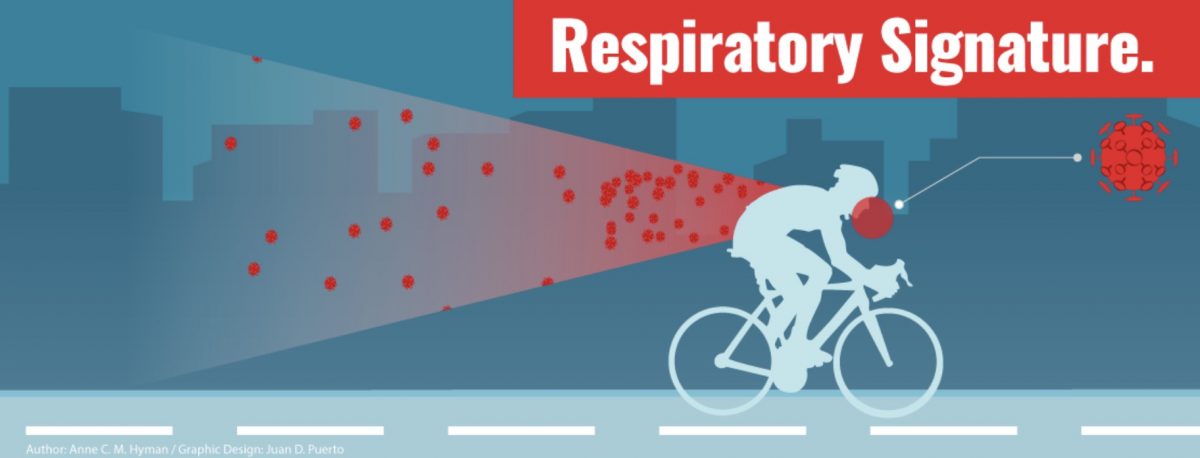
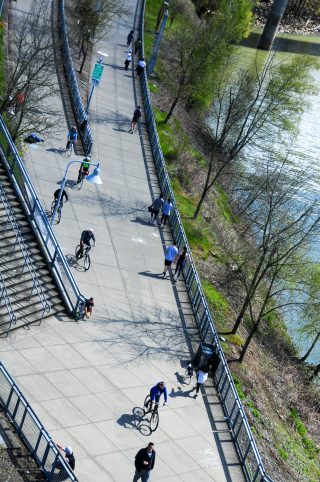
If we take what Corsi says seriously, the things I saw — and even did myself — outside yesterday should be cause for concern. Some parts of our city reminded me of Sunday Parkways.
North Willamette Boulevard was (once again) packed with people. The popular section along the bluff was packed. So was the section between Rosa Parks and University of Portland. In both areas, the number of people on foot and using bicycles far outnumbered those using cars.
Down on the Esplanade, it was even more shocking. I took a telephoto lens to shoot from the Steel Bridge because I knew it would be busy and I don’t want to risk my health or that of others just to get a few photos. I’m glad I did because the path was packed. People tried to pass each other with distance, but it was simply impossible given the number of people and the width of the path.
Over at Mt. Tabor Park, despite the ban on driving on roads inside the park, crowds still congregated on the road near the reservoir and passed closely by one another on dirt trails.
Advertisement
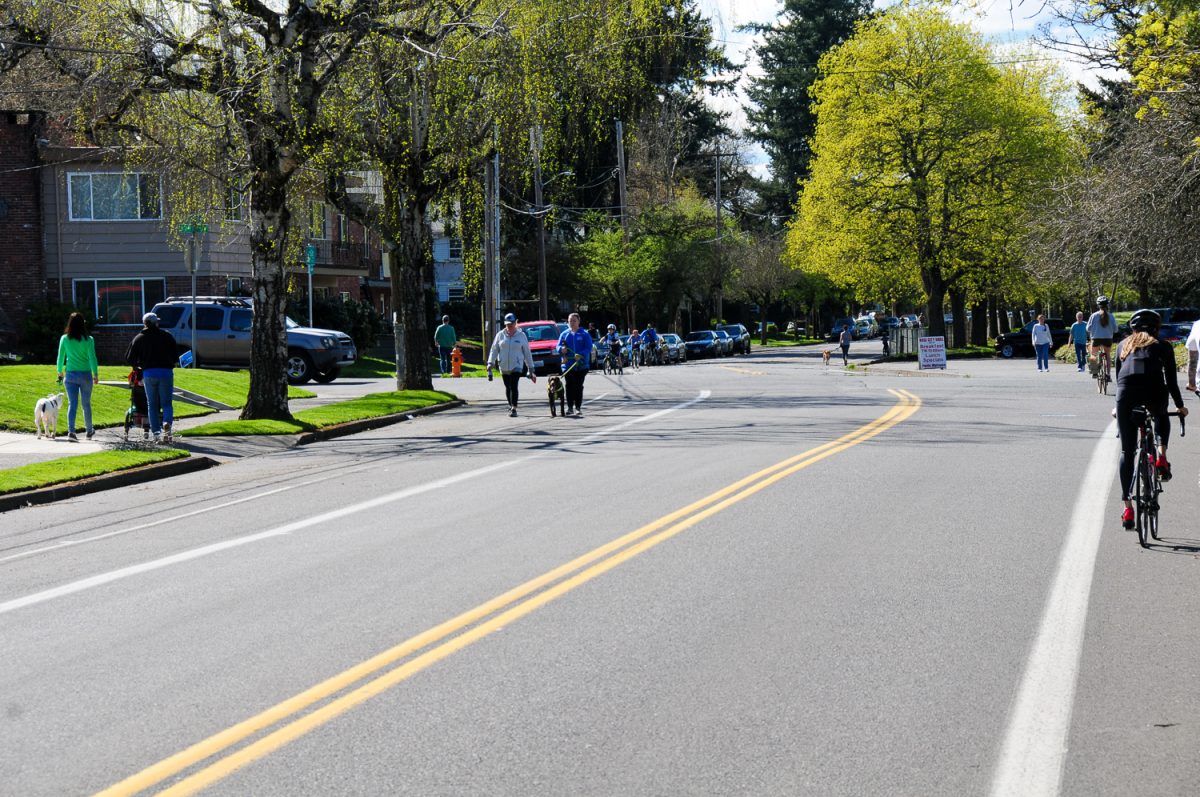
Neighborhood streets adjacent to Rose City Golf Course were also crowded. NE Sacramento felt very similar to Willamette Blvd with many people walking and biking and jogging in the street to avoid close contact on sidewalks.
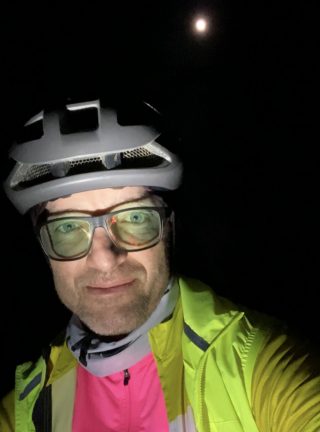
One change I’ve noticed out there in the past few days is that some people are now wearing masks or bandannas. Corsi from PSU told The Oregonian that those measures risk giving a false sense of security.
So what is a responsible bicycle rider supposed to do? Only ride indoors if you can. Or don’t ride at all. Or tell our city, county, and state to take immediate action to cordon off more temporary space on our roads and bridges for people and less space for cars.
Another option is to only ride in times or places where you can maintain as much solitude and distance from others as possible. Last night I left my house at 9:00 pm or so to ride through Forest Park. It was just the moon, me and a bunch of deer mice.
Here’s that story in The Oregonian again.
Does this change your feelings about biking outside?
— Jonathan Maus: (503) 706-8804, @jonathan_maus on Twitter and jonathan@bikeportland.org
— Get our headlines delivered to your inbox.
— Support this independent community media outlet with a one-time contribution or monthly subscription.


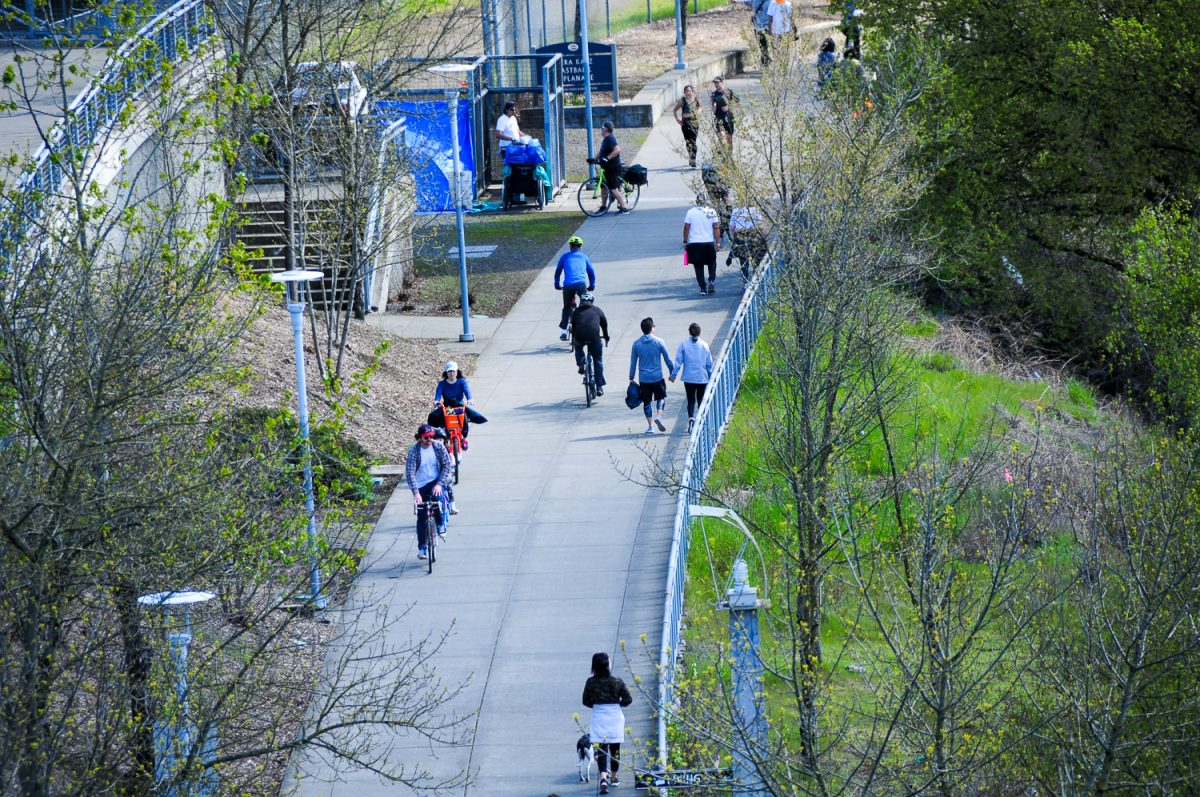


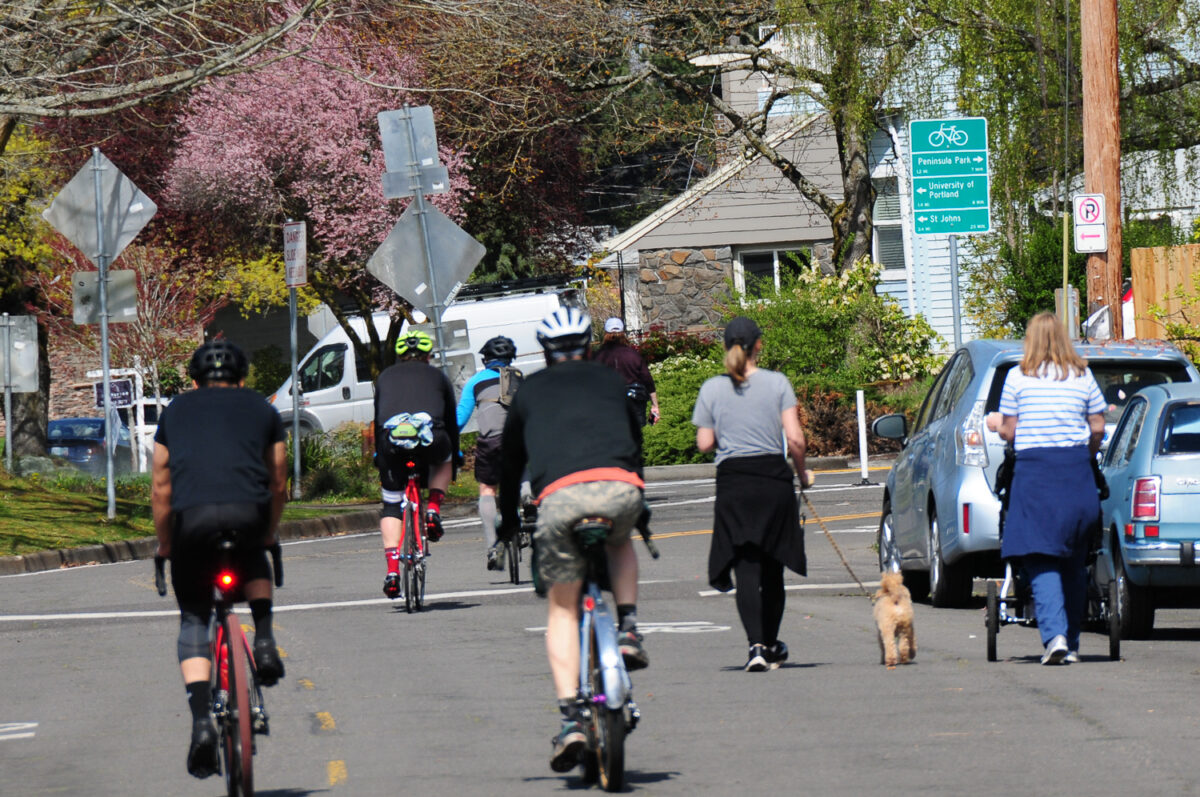

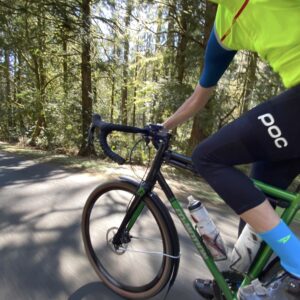


Thanks for reading.
BikePortland has served this community with independent community journalism since 2005. We rely on subscriptions from readers like you to survive. Your financial support is vital in keeping this valuable resource alive and well.
Please subscribe today to strengthen and expand our work.
Completely agree Jonathan. I did a midday ride last week and avoided the Esplanade, as you mentioned, there just isn’t enough space. Similar to you, I’ve either changed routes, choosing thin bike lanes on major roads or changed times, I hit Forest Park at 5:30 this morning.
Yeah I didn’t mention it in the story, but the other thing I’m doing is avoiding paths and narrow bikeways. The problem with that approach of course is that by doing so I am putting myself closer to people driving cars at very high speeds and with a growing lack of f***s to give about anything apparently. This is why we should cordon off sections of big streets with barricades/cones/planters/signs to make them safer for bikers and other non-drivers.
The time to do that is after the crisis has passed. Or so I hear.
“One change I’ve noticed out there in the past few days is that some people are now wearing masks or bandannas. Corsi from PSU told The Oregonian that those measures risk giving a false sense of security.”
I’ve heard two things about masks, in addition to CDC coming around to support them (verify for yourself, fact-checks welcome):
1. They reduce the volume and range of spreading droplets by the person wearing the mask, helping protect other people.
2. They discourage the person wearing the mask from touching their face (mouth, nose, eyes), considered to be a common transmission vector.
“So what is a responsible bicycle rider supposed to do? Only ride indoors if you can. Or don’t ride at all. Or tell our city, county, and state to take immediate action to cordon off more temporary space on our roads and bridges for people and less space for cars.”
Take the lane.
Corsi is NOT a disease expert. He is an engineer. This NPR article pretty much says outside transmission is much less likely than indoor transmission – based on data and opinion by a researcher that actually studies how bio aerosols spread.
https://www.npr.org/sections/goatsandsoda/2020/04/03/825639323/scientists-probe-how-coronavirus-might-travel-through-the-air?fbclid=IwAR0JXZWgYDUquwa9YEN2rV3szSCZhiXMI0hE-Y1hgNyIxv4FZkrEDSniUbQ
This needs to be emphasized more. Every honkey is weighing in on this, without the necessary expertise. This is the state of the country now — every know-nothing knows everything, with very high confidence.
All I know is that the covid molecule is practically gigantic. It is too heavy to stay in the air very long.
I’d rather exercise every day and take my chances, and clearly so would a lot of people.
Droplets fall out pretty fast, but true aerosols can float around for awhile…hours.
https://www.medrxiv.org/content/10.1101/2020.03.23.20039446v2 (preprint; not peer reviewed; widely cited)
Asymptomatic influenza: https://www.ncbi.nlm.nih.gov/pmc/articles/PMC4586318/ (Leung et al, Nov 2016): “In outbreak investigations where infections were virologically confirmed, we found a pooled mean of 16% (95% CI: 13%, 19%) of infections were asymptomatic, whereas in longitudinal studies in which infections were identified using serology the point estimates of the asymptomatic fraction adjusted for illness from other causes fell in the range 65%–85%.”
Today Dr. Fauci estimated (no data yet) 25-50% for asymptomatic SARS-CoV-2 carriers: https://www.npr.org/2020/04/06/828061364/fauci-half-of-those-with-coronavirus-may-have-no-symptoms (~2:50 min). As David H says below, we’ll know more when CoV antibody tests become widespread. That podcast also quotes Dr. Harvey Feinberg (~1:50 min) explaining why masks probably help.
The Santarpia et al (March 23 2020) study I cited above includes the following in the abstract and explains more in the main text. Note the distinction between droplet and airborne (aerosol): “Disease [covid-19] spread through both direct (droplet and person-to-person) as well as indirect contact (contaminated objects and 20 airborne transmission) are indicated, supporting the use of airborne isolation precautions.”
Also, from van Doremalen et al, March 17, 2020 (https://www.nejm.org/doi/10.1056/NEJMc2004973 ): “Aerosols (<5 μm) containing SARS-CoV-2 … were generated … to create an aerosolized environment. The inoculum resulted in cycle-threshold values between 20 and 22, similar to those observed in samples obtained from the upper and lower respiratory tract in humans.
…
SARS-CoV-2 remained viable in aerosols throughout the duration of our experiment (3 hours)."
(Yeah, heavily extracted, but I think in context with the original. It's quite readable when I brush over the inline jargon. "Cycle threshold value" is when a PCR test can be detected above the background signal.)
So, while I respect the CDC digested public info you quoted, and while the recent rush of CoV studies have not been reviewed or replicated yet, I am personally inclined to take a bit more caution than CDC suggests. Just last week – when riding together was discussed here – there was still plenty of thought that six feet was fine, and that only droplets carried enough innoculants to cause CoV disease. Information, including data-driven science, marches on, and I like to be aware of it and adjust for the contingencies it suggests even if it means I might be slightly overcautious for a short spell. That's not stopping me from riding or walking every day, but I am trying to be aware of those exposures and risks, and minimize them.
Did you mean for your second paragraph to confirm the thesis laid out in the first?
Masterfully tactful.
It seems the jury is still out on whether this kind of thing is a significant concern. Everything I’ve read is that indoor spaces are of most concern, and in the outdoors people should just avoid crowding together like they were at Multnomah Falls. There isn’t any real evidence that the virus spreads easily from people biking past each other or behind each other, and I would defer to the medical professionals on this rather than an engineering professor who has no medical background. If state and local governments want, they can change the guidelines, but until then they can hardly blame people for engaging in healthy outdoor recreation after being cooped up inside all week.
“Everything I’ve read is that indoor spaces are of most concern”
Except for that outdoor soccer game in Italy that turbocharged the epidemics in both Italy and Spain.
From what I’ve seen from Euro Soccer stadiums there are 20,000+ fans literally shoulder to shoulder in a very confined outdoor space. It is nothing like Mt. Tabor or the waterfront. I’m guessing they are 2 inches apart instead of 6 feet. Nobody is advocating dense crowds like that.
Come on. A soccer game is a situation where thousands of people are literally yelling and screaming, spittle flying everywhere.
I’m not convinced by what he has to say, but his credentials seem to be in order. He specializes in indoor air quality. I think that lends very specific and relevant expertise to the topic.
I’m still only riding solo on the road and not doing any trails on the mountain bike. I’m avoiding multi use paths due to all the foot and bicycle traffic. That said I’m still riding outside every day but only where I know I can keep distance from other users. I don’t think anyone should be reckless but riding outside by yourself appears to be safe based on the best known data at this point. If the science changes I’ll change my behavior.
A level-headed cautionary approach based on available data? Get out of here with that nonsense.
You either need to be in full panic mode, locking yourself in the house, making poor people pick and delivery your groceries, or you need to be whipped up into anti-government fervor, vowing to never change your behavior. There is no middle ground here.
By “making” you mean “employing” as in “helping people earn money when they otherwise could not”, right?
I think our whole approach to managing outdoor space is a little messed up:
Wouldn’t it make sense to:
1) Close access to all state, regional and local parks AND tell people not to do outdoor exercise altogether (biking, running or walking on your neighborhood streets) except for maybe a minimum amount of time allotted for dog walks. This is would be the “minimize risk at all costs” strategy, but to be coherent and consistent, we would also have to exhaust all other efforts to minimize risk as well.
2) Keep all parks open and tell people to to continue to do outdoor exercise while spreading out as much as possible (and accept that there are moments when 6+ feet of separation isn’t possible). This strategy would recognize that there are mental and physical health benefits from outdoor exercise and would assume that the risks from outdoor activity are probably still reasonably acceptable given the benefits. With this strategy, we might even try doubling down on measures to limit risk from indoor, spaces like grocery stores, apartment elevators, and construction sites, where people are in close proximity and have to touch things.
If we’re going to have to fight this virus with social distancing for the foreseeable future, I just wish we see research, or at least professional guesses of the effectiveness and costs of different distancing policies. We need to know the relative risks of everything we do, or else we might overlook things that are actually dangerous while living in fear of everything that might carry any risk.
The O’s story amplifies the opinion of an engineer who has worked with indoor air quality over the consensus of public health experts. It may not be apparent, but there is a huge difference between theses disciplines and the latter understands risk of communicable disease much better than the former. While I agree there is room for considering these issues, the story in the O and the recreation of it here, do not present a useful framework to have this discussion.
That’s good to hear SD. Comforting at least. I was going to just do a story about how the streets and paths were packed and share some thoughts and pics. When I saw The Oregonian story I thought there was a connection worth making. Thanks for sharing your opinion. FWIW I’ve heard people say engineers aren’t health experts so they should be listened to… But health experts aren’t engineers so should we consider that as well? And yes, I know this is a public health issue, but that doesn’t mean other topics don’t come into play.
I think in general the crowds I’m seeing on streets and paths are not a good thing. Even if we don’t fully agree that Corsi’s opinions are valid, people are certainly exercising outdoors in too close proximity it seems.
I do agree that it is detrimental to have DOT bureaucrats and, by extension, highway engineers making decisions that have tremendous impacts on health without adequate input from public health experts.
I’m just confused after reading all of that, you still just use that information to further justify your preexisting position that roads needs to be closed to enable and encourage more folks outdoors… but more safely. I felt like if we were really taking the guidance to heart and doing as other countries have, our lock down wouldn’t encourage all these leisure trips outdoors to the park in the first place and only exempt exercising and minimal dog walks in the neighborhood. I also question the value of all the reporters going to these crowded areas, adding to the problem, just so they can take a photo and say “here look! There’s a problem with crowding!”
Then there’s the woman on Nextdoor who complained about people riding bikes on streets not getting over far enough when she drives past, because she’s worried that she’s breathing their air. She said she could close her windows but “Who wants to drive with their windows closed on a nice day?” Not kidding.
Take the lane.
Saturday morning, I Ieft my house at 9 hoping for a few laps of Tabor, or maybe shoot up the cemetery and then over to ‘willegar for a 20 mile loop.
All I can say is, 9 am on a weekend is not nearly early enough. I bailed after one quick lap of Tabor, rode the ’70’s to 92nd to Rocky Butte, and then home. Wow, – just wall to wall people and dogs, often 3 abreast, giving me lots of stink eye in spite of me being the nice guy wearing a mask, giving oodles of space and slowing to a crawl.
Nextdoor is a dumpster fire
Who would choose to live among those people?
They’re everywhere! Like some kind of virus. Impossible to avoid.
the silver lining is that nextdoor isn’t anonymous
Given how much people traveled overseas and all over the US up until mid-March and that the disease was first identified last December (and may have been around longer still), I just assume we’ve all already been exposed to the virus at some point or another, in some quantity. Until there’s a widespread Covid-19 antibody test available at minimal cost from our local drug store, we simply won’t really know, will we?
Given that no one has immunity to this virus, we would have millions sick already if we had all been exposed. This is why social distancing is so critical.
I find it helpful to put everything in perspective. According to the BBC and other news outlets, about 80% of the people who have gotten the virus have either mild or no symptoms at all, not bad enough to be tested anyway. Such people may still be unintentionally spreading the virus. Everyone who is getting tested (or supposed to) is displaying at least some of the symptoms such as breathing difficulties, but even most of those individuals don’t have Covid-19; they may have flu, colds, allergies, emphysema, chemical injuries, etc. What is widely published are the cases where people have been tested and found to be positive with Covid-19, the 20% who are confirmed to have it. Of those, over 75% (15% of total cases) are tested and then sent home to self-isolate, at least in those countries with socialized medicine. Of the remainder who are kept at hospital (25% of the sick or 5% who have been exposed), about 50-80% fully recover (2.5-4% of the total cases). The death rate is somewhere between 5% in Italy and Spain, and 0.05% in Germany. The common flu has a death rate of 0.01% and a total of about 2.9 million people died in the USA last year of all causes, including over 30,000 in traffic crashes + over 2 million serious life-changing injuries. I’m looking forward to the next health emergency when all motor vehicles are banned as deadly killing machines.
And, if we had all been exposed, why would the number requiring hospitalization keep climbing?
You’re wrong.
Check out https://govstatus.egov.com/OR-OHA-COVID-19
In daily COVID-19 test results in Oregon, we find only ~5% of people tested test positive. These are people who presumably have symptoms or are in contact with other people who are positive and yet the result for this group is that 95 out of 100 people don’t have it. There are LOTS of people who have still been unexposed to the virus.
Much of our progress has involved overcoming our innate animal instincts and desires, such as equality under the law. I think further progress can best be made by understanding and acknowledging the way we tick, which explains, for example, the success of capitalism over communism.
Humans are tribal animals. When the enemy is at the gate, the pheasants huddle under the castle walls. The call to gather has compelled me and thousands of other Portlanders of late. We are a community nurtured over a long period by events like Sunday Parkways. Now, we are asked to huddle in our huts. That’s alien to our nature.
Good point. As all the other places people gather get shut down, people who miss that are looking for whatever’s still open for gathering, and they’ve found that with parks. And once they get to the park, they behave as if they’re in a magical space where the virus doesn’t exist.
Much of our behavior makes sense when viewed through the lens of evolutionary psychology.
“ Humans are tribal animals. When the enemy is at the gate, the pheasants huddle under the castle walls. The call to gather has compelled me and thousands of other Portlanders of late. We are a community nurtured over a long period by events like Sunday Parkways. Now, we are asked to huddle in our huts. That’s alien to our nature.”
middle of the road guy April 7, 2020 at 7:31 am:
“Much of our behavior makes sense when viewed through the lens of evolutionary psychology.”
I find few things less persuasive and less helpful than these “by nature” arguments about human behavior, especially in the present situation. Most of these evolutionary biology conjectures are not testable or falsifiable so they spread bogus ideas like a contagious virus without a cure. They also stop the conversation about the many demonstrable ways society and culture shape human behavior. The evidence you cite actually makes the opposite, compelling point: The success of civic programs like Sunday Parkways in encourage people to get out and use our public right-of-ways to promote active transportation and safety in numbers while building community and solidarity are actually one factor (among many) that make us more socially and civically oriented in Portland, at least compared to other places. It is no small tragedy that now we have to practice the opposite to be safe and defeat the virus.
But maybe not if as Jonathan argues we use this as an opportunity to expand the physical space for people to bike, walk and be out of doors together.
I don’t think they were saying those things to rationalize or justify the behavior, just to explain it. And there is actually a substantial amount of research into the history of human culture to show those very things.
According to the Farmers Almanac, SUPER PINK MOON: THE BIGGEST AND BRIGHTEST SUPERMOON OF THE YEAR is Tuesday, April 12.
Depending on my mood and the weather, I’m probably going to do a personal naked ride at midnight, no crowds, just me and Gaia celebrating the arrival of springtime.
The supermoon is actually tonight, April 7! Change of plans!!
In today’s Oregonian is an article saying that thanks partly to updated data, and thanks partly to distancing efforts, the outlook has improved greatly for keeping “the curve” below hospital capacity in Oregon.
Perhaps not coincidentally, here in Minnesota (whose timeline for every major incident – crossing of various infection and death thresholds, institution of various distancing measurements – has tracked within a day or two of Oregon through this entire thing and our CovidActNow graphs have always looked remarkably similar) our major newspaper has exactly the same message today.
Folks, what we’ve been having to do sucks, but it’s working. We probably don’t have to tighten things down too much further. We don’t have to close all the parks and stay indoors, as some parts of China and Italy have done.
We’ve slowed the transmission rate down enough. The goal was never to get it to zero, just to squash and spread out the peak, and this is now happening. Not to say we can likely restart social activities anytime soon – we may have to live with big restrictions for months to come, and our state and national leaders have repeatedly failed to be honest with us about just how long that will be – but the silver lining maybe that this is as bad as the restrictions need to get.
I thought it was really nice to see everyone out enjoying the weekend off. Too bad we basically live in a third-world country where the joys of having a Sunday off to go to the park are beyond the reach of most wage slaves.
Who rides on the Esplanade or in the parks anyway (except Tabor). Those places are always too crowded to ride, unless you’re tourist on a escooter.
The streets are pretty empty, traffic a tiny fraction of normal, so just ride on the streets where you normally ride.
One park people do ride through (lots of commuters) is Willamette Park, because the Greenway Trail runs through it. I sympathize with them because Parks is encouraging everyone who wants to exercise to come to parks to do it, and the fact that Parks is keeping parking open at Willamette Park is bringing even more people there, including lots who seem oblivious to other users. The trail also runs through the boat launch parking lot, which is extra crowded because Parks is keeping it open while other boat launches have closed.
The alternatives to the Greenway Trail (SW Macadam? SW Corbett?) aren’t great, but as you said, traffic is lighter now, so those may become more attractive to commuters.
What about children learning to ride and become the next generation of bike advocates for people and the planet? Geez, the community of cyclists is way bigger than dudes in spandex going on thrill rides.
Like most, I’ve been riding a lot during the shutdown. It’s part good weather, part the best way I know how to stay mentally healthy during this stressful time. I realized early on though that high traffic paths or trails (like the Esplanade or Leif Erikson), or even moderately trafficked paths (like the Columbia Slough and Saltzman) create situations where it’s difficult to safely keep a 6 foot distance. I too read the article you cited from the Oregonian Jonathan, and have concerns about 6 feet not being enough. Combine that with heavy breathing, snot rockets, and spitting, and cycling can be reckless in the time of COVID-19.
I’m trying to reconcile that potential recklessness, with my desire to continue riding though, and am thinking critically about ways to continue riding without being reckless. One thing I’ve done week over week is find more and more barren streets to ride. It’s difficult in the city (I live close in SE), but possible. Riding less busy streets like the 28’s instead of the Esplanade to go North is an example. And once you get out far enough, like riding Highway 30 out to Newberry up to Skyline, you may not pass or be passed by anyone the entire time.
We also have to change other typical riding behaviors – we can’t all congregate close to each other waiting for a light. We can’t give in to that urge to draft off someone, and cyclists, runners, and pedestrians have to give each other more time and grace to safely pass one another (I’ve found this is the hardest part).
Also, if you’re anything like me, having a nose that’s like a faucet that is always in the on-position, we need to fight the urge to spit, snot rocket, sneeze, or cough in any scenario when people are around or hard surfaces are present (like railings on a bridge) which we could infect others.
The face-mask thing is interesting too, and I think they merit a whole article about using them while riding. The past couple days I’ve ridden with a bandana (I now know the ineffectiveness of that particular material and am seeking an alternative), and there’s a steep learning curve trying to figure out how to breath properly, blow your nose, and drink/eat on the bike. Not to mention how to keep from constantly touching your face trying to keep it on correctly.
I recommend the men’s boxer brief technique: https://www.wweek.com/news/2020/04/06/an-oregon-dentist-showed-us-how-to-make-covid-19-face-masks-out-of-boxer-shorts/
It stays on very tightly and covers my entire nose and mouth, but it’s comfortable and more breathable. It also doesn’t fog up my glasses, which is critical while biking! And I don’t find myself constantly fiddling with it like a normal mask. As the dentist in the video notes, you can also tuck a mask in between the layers if you want additional protection.
Also, you end up looking like a ninja.
Love it! 😀 At least in part because it reminds me of Black Adder, A Bout of Insanity -https://youtu.be/G2DCExerOsA
Yup, yesterday as I approached the Sellwood Bridge from the west side, I saw an influx of pedestrians and bikes around, so I pulled my mask up while I was around other people. But between the difficulty in breathing and the fogging of my glasses it’s really difficult to manage.
I do my longer neighborhood walk to parks and scenic spots in the morning (before 9am) and by midday or afternoon, opt for either just hanging out in the backyard with the fur baby, or do a short walk on less busy streets, often walking in the middle of the street. It’s been working well for me.
It’s hysteria on top of hysteria. This isn’t bubonic plague. If our biggest problem was people riding outside and walking, geeze wouldn’t that be great? Here is bike portland shaming people for, um….getting around? It makes no sense. This isn’t mardi gras. Just people getting around.
Fortunately most people seem to understand it’s not just people getting around.
Riding solo at night is a daunting idea to most women.
I find it interesting that the reality is very different in SW Portland. Since we don’t have sidewalks, people walk in the middle of the street on neighborhood streets and take over the space naturally. And we don’t have that much recreational biking because of the hilly terrain, which means that bicyclists are further spaced out.
The Springwater has been my primary route… but not so much now. I’ll start out on the trail early when it’s still mostly empty, but I’m switching to streets to get back to Sellwood, because by late morning on nice days the path is clogged with people.
We need to really prioritize people over motor vehicles on neighborhood streets. Why not put temporary diverters (allowing access for residents & delivery vehicles) every couple of blocks on greenways?